Understanding OCP miniApps®
OCP miniApps® are built to enable anyone to benefit from Omilia’s 10+ years of experience in deploying voice automation solutions. Each of the OCP miniApps® is designed to be a complete solution and encapsulates the translation of complex behaviors and processes into a conversational format. All the tools are aligned to solve a single problem with maximum accuracy and simplicity of execution.
With a few minutes of configuration work, not coding, you can create a conversational interface that captures intent or needed data from a client (let’s say, an address), converting naturally spoken words to text (including understanding all the various accents and ways people pronounce words, not to mention voice mannerisms such as saying “ummm” or maybe even coughing or clearing their throat) using disambiguation and error handling best practices with state of the art speech recognition accuracy and security. This is a mouthful but the bottom line is you spend a couple of minutes configuring OCP miniApps®, link to your Orchestrator flow application, and your problem is solved. Using a simple wizard, and no training, anyone can use OCP miniApps® to apply all the following capabilities to a problem:
-
Capture the caller’s naturally spoken words, and convert them to text
The era of trying to figure out every possible way a caller could say something is over. We’ve learned over the years that the secret to good automation is to ask better questions of your callers. The use of OCP miniApps® naturally follows a strategy proven to work across years of automation best practices – asking a specific question while accepting an unstructured response. Being ready, in essence, for any response to that question.
If you ask a caller to say their date of birth, you need to be prepared for “January first nineteen-hundred”, “one one one nine oh oh”, “January … uhhh…. one… I guess… nineteen aught… yeah that’s right… I think…”… It’s not the caller’s job to figure out how to say their birthdate your way, it’s your job to understand the caller’s speech as any human would.
Trust is built, and understanding enabled, by asking the right questions in the right order and learning to understand any response that comes back within the context of the question.
-
Context-based tuning for maximum accuracy
Another outcome of Omilia’s experience is that aligning every element of the technology (speech recognition, language understanding, machine learning) to the context of the question enhances the accuracy of the results that meet or exceed human understanding.
If I know I’m expecting a ZIP code, I can disregard any results that are not tied to ZIP codes. The natural structure of OCP miniApps® (built to capture a specific element in a specific way) enables the capture to be tuned for optimal accuracy and results.
-
Redaction of caller information via masking or AES-256 Encryption
Another benefit of the natural structure of OCP miniApps® (built to capture a single data element, wrapped into a specific context) means that it’s easy for customers to control what data is masked or encrypted in OCP miniApps®.
-
Are you asking for Information that only the caller should know (for example, PIN number)?
Then select “irreversible masking” in the OCP miniApps® User Interface. The data captured by the invocation of OCP miniApps® will be permanently masked and forever inaccessible to anyone. -
Are you asking for information that is considered PII, PCI (credit card number)?
Use AES-256 encryption. Only admins from your organization will be able to decrypt the information. Since each invocation of OCP miniApps® is separate from other OCP miniApps® invocations, you can carefully classify each element of data that the Omilia system captures for you.
-
-
Disambiguation and Incomplete responses
If you ask a caller “How may I help you”, and they say “300”, you know you need to clarify that response. Maybe you didn’t hear them quite right. It might be good to say “do you want me to transfer you to extension 300?”.
But if you ask a caller “How much money do you want to transfer”, and they say “300”, there is no need to ask additional clarifying questions – except, perhaps, to confirm whether it is “dollars” and not “euros”.
Also if the caller says “I need some information in regards to my card”, the request is not complete and the miniApp can ask “What information do you need about your card” to make the request more specific.Humans ask clarifying questions all the time, “I’m not quite sure I heard you…”, “Did you mean __, or was it something else?”. This is a key element of building trust, which is a key element for getting callers to use an automated system.
Think about trying to do all of this in your standard IVR flow editor. How many hours do you think you would need to spend trying to figure out how to implement this level of logic? OCP miniApps® use simple wizards and drag/drop menus to configure this. Read more about ambiguous intents.
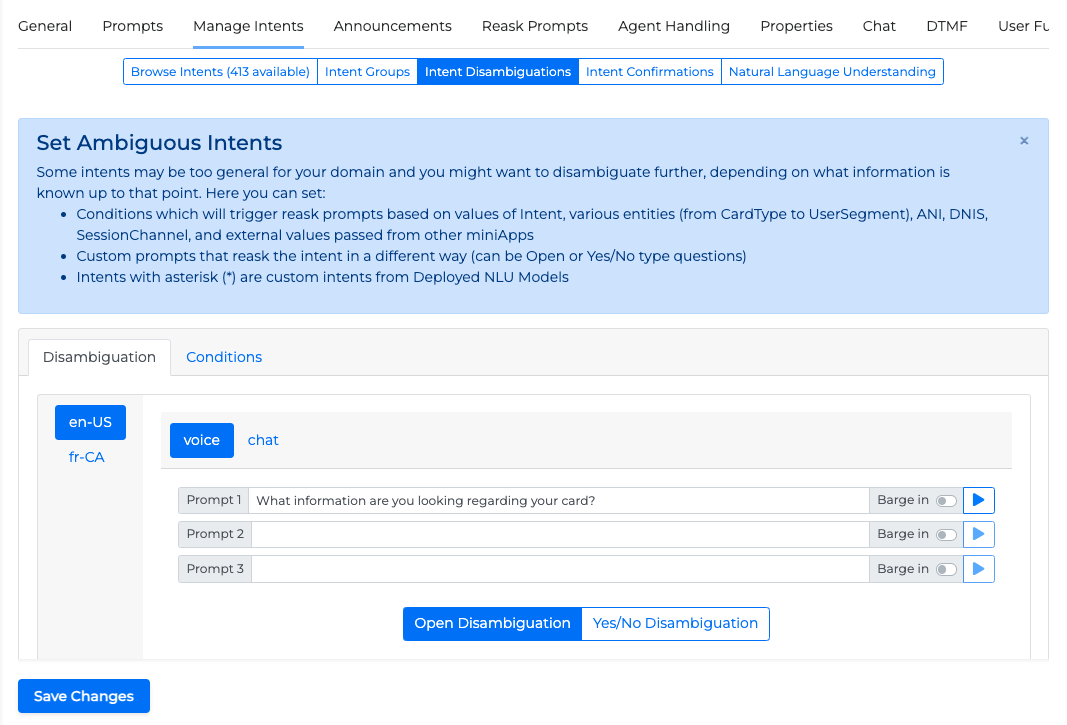
Intent Disambiguations -
Validation
You can choose the way the data provided by the caller is validated against the preset rules. You can add multiple validations and prioritize them accordingly.
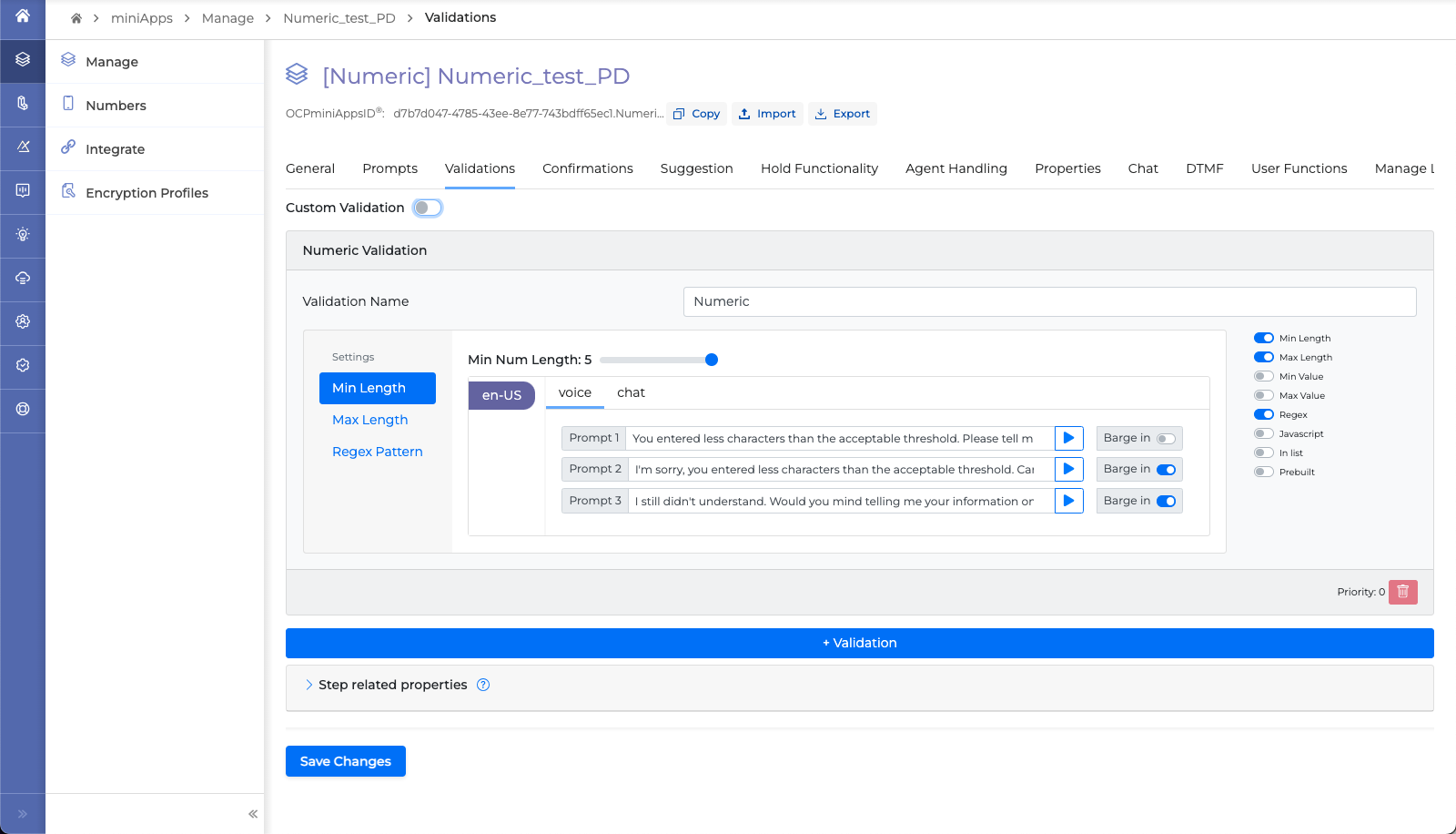
-
Confirmation
How confident are we in the result? Should we ask the caller to confirm? Maybe we should only ask if we’re less than 90% confident we got the answer? Maybe 80%? Control how you manage your confirmations.
People do not always repeat back the answers to their questions… If your callers have to confirm literally every response, it can be frustrating. “You said __, right?” It takes time, and it’s something a human doesn’t always do.
Being able to configure when you ask for confirmation, and when you don’t, is a very big element of building trust. Plus, think about trying to deal with this in the IVR.
Confirmation Think about all the additional programming work involved with trying to analyze when and how to confirm and validate. OCP miniApps® use a simple wizard that you can deploy in seconds.
-
Allow a caller to “pause capture” for a moment, if needed
Did you just ask your caller something they didn’t expect? Do you ask “what is your member ID?”, but maybe they didn’t have it ready or memorized? If they were talking to a human they could say “uhhh… wait a moment… oh man… I never have this at hand….” They can ask for time because the human understands.
Automation solutions can do this too. “If you need a moment to find your member ID, just say ‘wait’. Otherwise, if you have your member ID, please say it now.” Being able to request a “pause” or “more time” is a natural part of any OCP miniApps®.
As with all OCP miniApps® features, you are just a few mouse clicks away from best practices that took years to develop.
You can read more about hold functionality.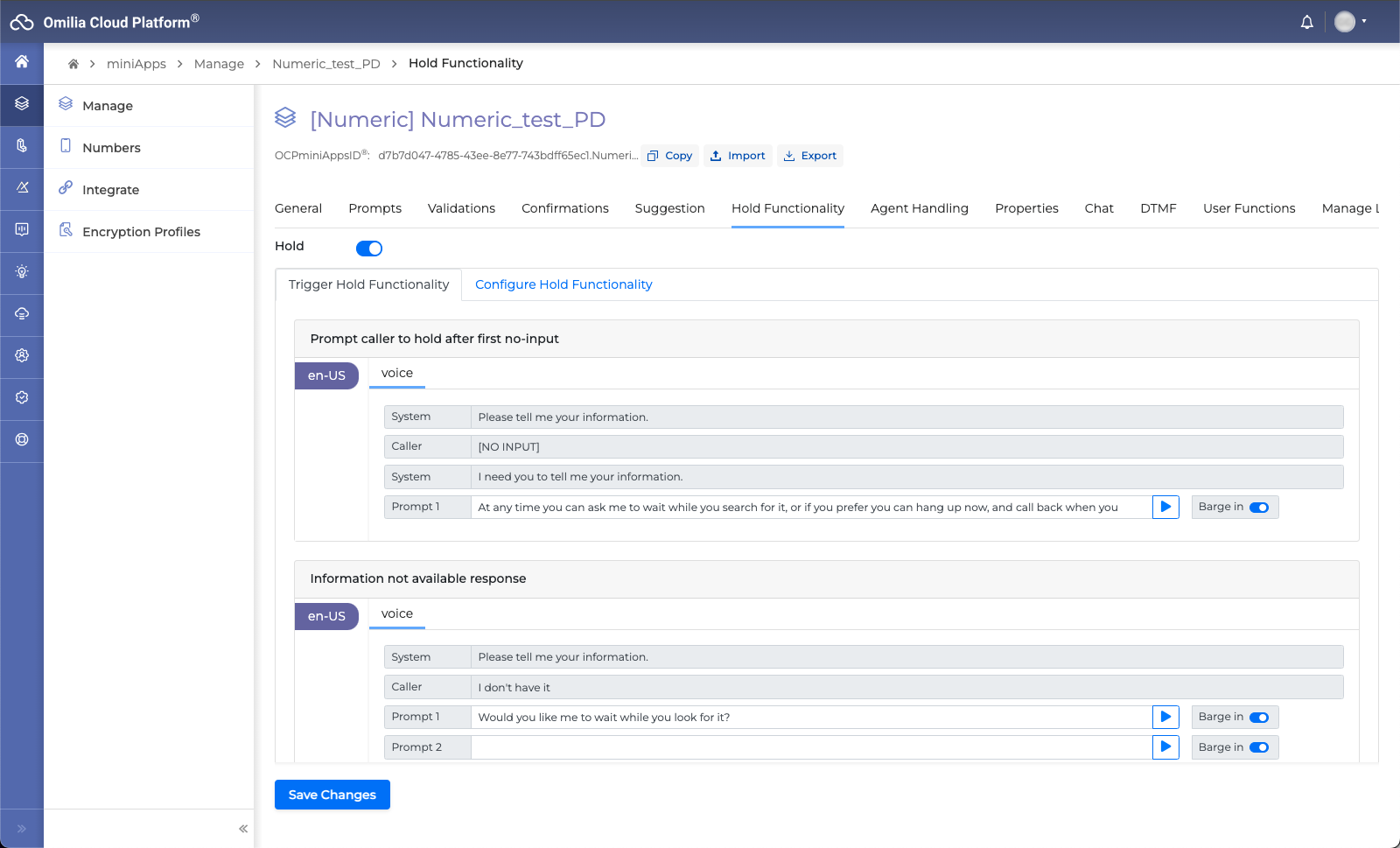
Hold functionality -
Retry and Error Handling properties
What do we do if we don’t get a useful response the first time? How many times do we retry? You decide! Is no response considered an error? You decide! On maximum errors, do you want to transfer or hang up? You decide! How about custom messages per error case? You got it! Want to have different thresholds for continuous and global errors? You got it!
IVRs have quite a lot of complexity around error handling and retry logic. OCP miniApps® eliminates the complexity and lets you configure the behavior with a few clicks, but offers a level of customization that is equivalent to something one could achieve with custom code. Adjust the miniApp behaviour to your liking and decide when and how the call ends depending on the type and number of errors that occurred in the dialog. All the error handling fields have built-in optimized default values, but allow you to fully configure them if needed.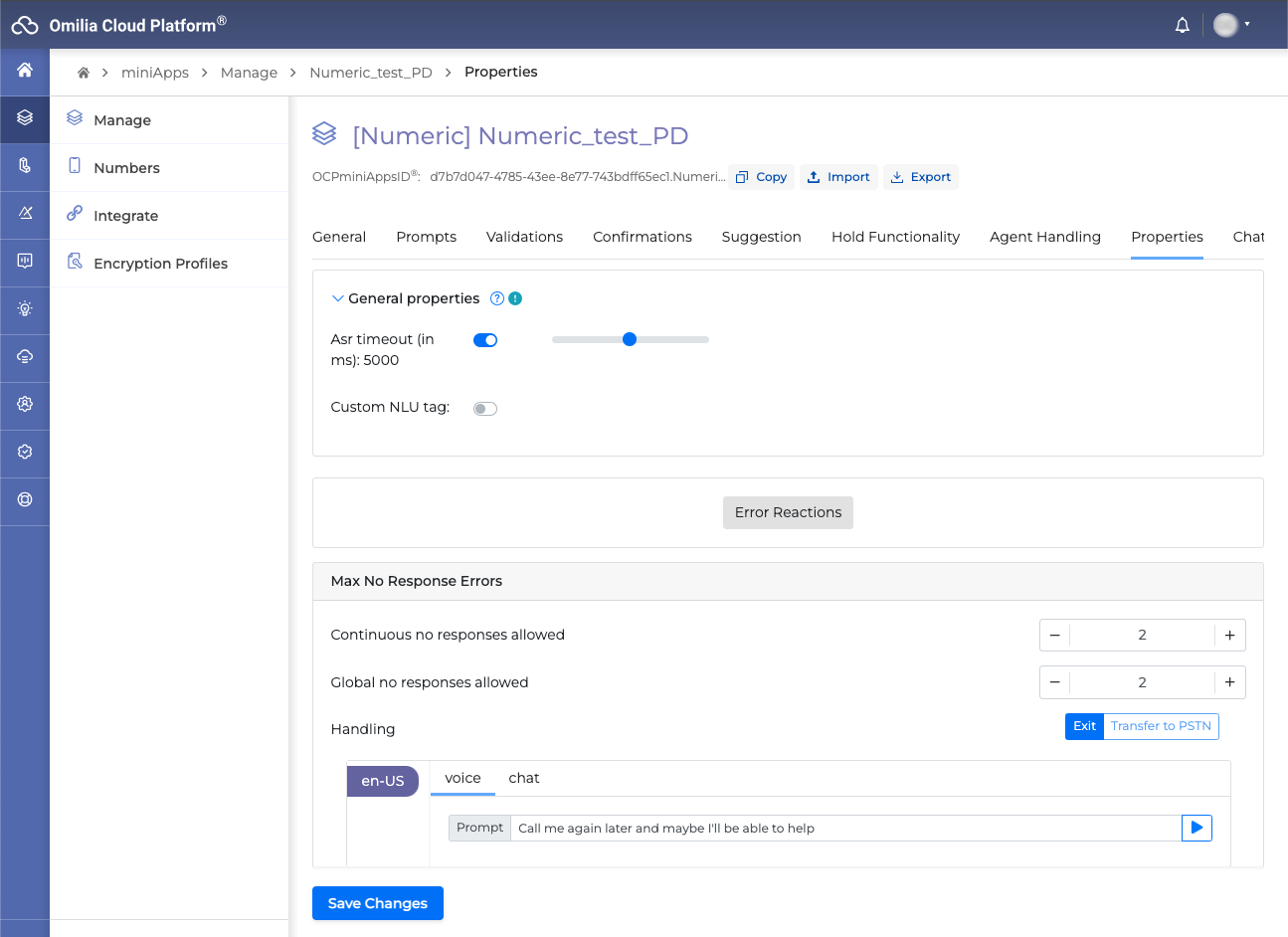
Properties -
Request for Agent Escalation
Asking for a live agentbecame the standard reaction to anyone calling a virtual assistant. The reaction developed systematically and as a consequence of poor conversational experiences, remains today as a standard human-to-bot reaction/interaction. OCP miniApps® encapsulate an easily configurable way to mitigate this behavior and keep a caller comfortable with the conversational experience. You can decide if the system will transfer immediately on any agent request or try to continue the conversation to extract more information from the caller. If someone immediately asks for a live advisor you can provide a comprehensive response: “I understand you want to speak to an agent, but the fastest and safest way is for us to continue together. Should we continue together?” or even: “I will get you to an agent. However, to get you to the correct agent, I will first need you to tell me the reason for your call.”
Not only do you build rapport with the caller by acknowledging the request, but you provide reasons to continue the call without an escalation.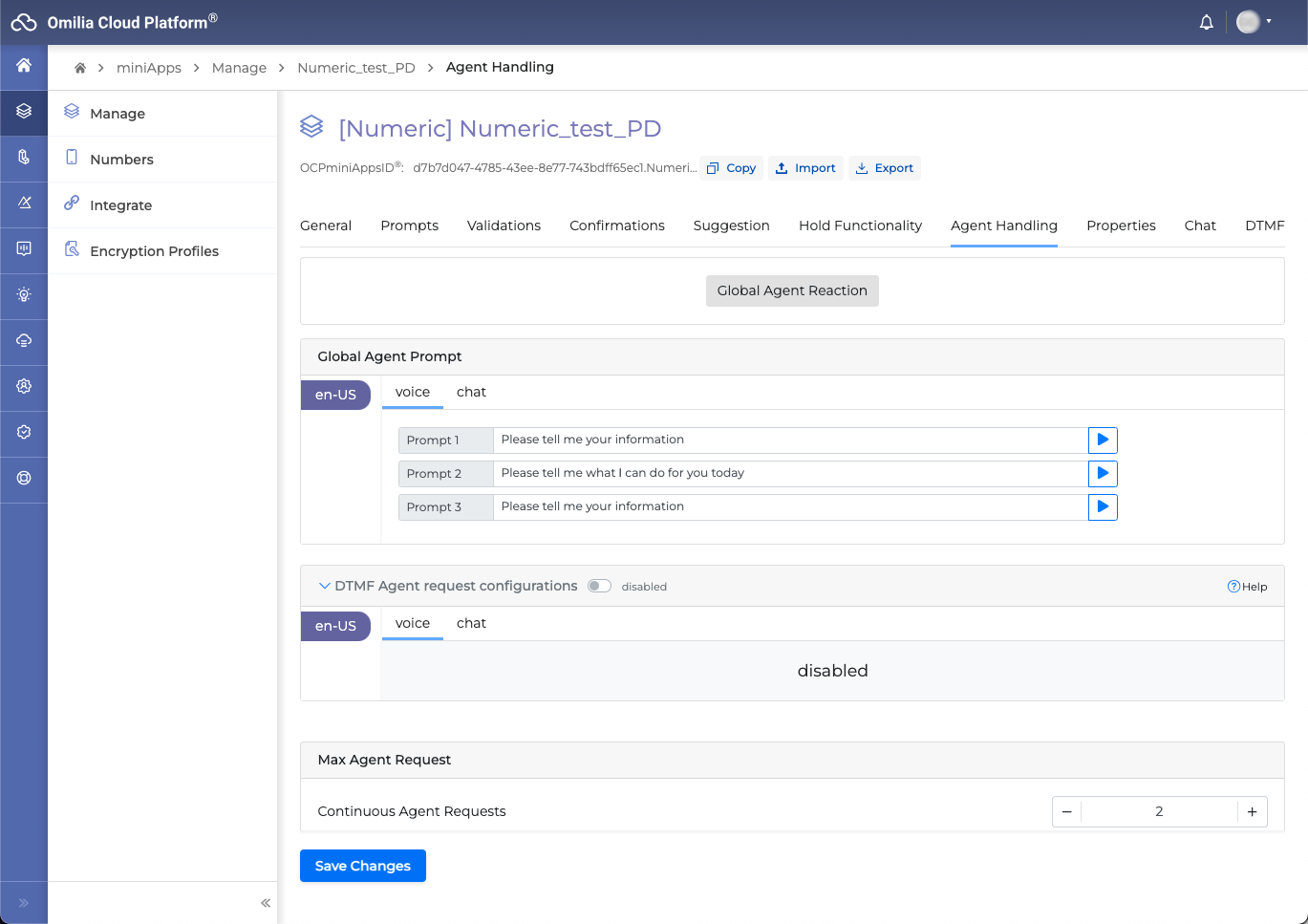
Agent handling -
Flexible reactions to enhance the natural feeling of each conversation
A conversation is never exactly the same. Even if you are performing the same task, a conversation should always flow naturally. That keeps users comfortable and enhances their trust in the interaction. Either by configuring acknowledgment of nice reactions towards the completion of a task or by having a selection of ways to express that you might have misheard or confused something, having a layer of fully customizable interaction features brings a natural feeling to your conversational experience on OCP miniApps®.
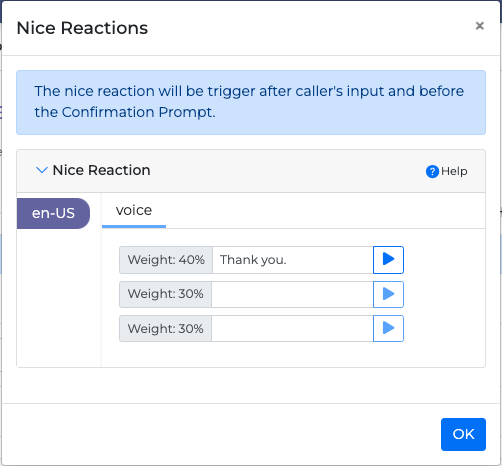
-
Speak over the IVR (or “Barge-In”)
You can define if a user should be able to interrupt the prompt playback or not. Either to improve the recurrent customer experience (when someone is calling several times, being able to interrupt the prompt and speed up the conversation is a great help) or to enforce some specific prompts to be heard, with a click of a button you can enable or disable the ability for users to speak over the IVR. -
Fail over to “touch-tone”
Similar to the agent escalation, many people will try to interrupt the conversation by simply pressing zero or any other key. In other cases, you might be migrating from a legacy DTMF application and your users are not yet accustomed to the new conversational behavior. The ability to configure playback prompts to guide the user’s behavior is key in such cases. Regardless of the user pressing 0 to reach an advisor or just pressing the keys that previously would lead to the skillset they are looking for, you are now ready to maintain a fluid conversation. No disruption.
Types of OCP miniApps®
A variety of OCP miniApps® currently exist with more to be released in the near future. You can gather more information about each type by simply clicking on the provided links.
OCP miniApps® features
The principle behind the OCP miniApps® concept lies in incorporating a standard set of features. These miniApps are developed with a focus on consistency and ease of setup and maintenance. The aim is to significantly enhance the task completion rate (TCR) within the self-services in which they are integrated.
Delve further into the vast array of features that OCP miniApps® offer.